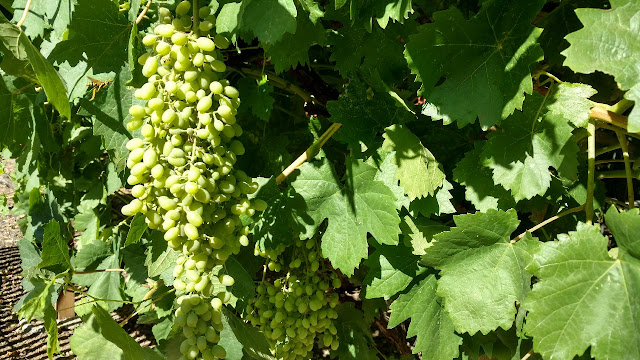
Beginners' class offered by Sacramento Home Winemakers

|
|
Learn to turn raw grapes into wine in a beginners' class next month. (Photo:
Debbie Arrington)
|
Got grapes? Maybe it’s time to learn how to make wine!
Sacramento Home Winemakers, a local club devoted to helping folks safely make their own vino, is hosting a beginners’ class, “Winemaking 101.” Set for Aug. 4 and 6, it’s a wonderful opportunity to learn a lot about the basics of turning raw grapes or fresh juice into something drinkable for years to come.
It’s not uncommon in our region for gardeners to grow grapes; vineyards obviously thrive in our climate. More and more grapevines are covering fences and trellises in suburban backyards.
Sometimes, those vines were planted by someone else – and came with the house.
“People are moving into new digs with small, home wine-grape vineyards, but they don’t know how to make wine,” says Gin Yang of Sacramento Home Winemakers.
Or you can get your grapes from someone else; this group has sources for grapes, too.
This class is designed for those aspiring DIY winemakers as well as a refresher course for folks who have made their own wine before. And the class comes in time for this fall’s grape harvest and the group’s New Winemakers Group Crush.
With seven hours of instruction, the workshop is divided into two parts: 6:30-8:30 p.m. Thursday, Aug. 4, via Zoom; and in person 9 a.m.-2 p.m. Saturday, Aug. 6, in Granite Bay. (Location supplied after registration.)
“We’ll guide you through the essential steps, throw in a little chemistry, taste wines, and have lots of fun,” say the organizers.
The workshop includes:
-- Steps for making white and red wines.
-- Resources for getting supplies and chemicals.
-- Safe use of winemaking equipment.
-- Where to source wine grapes.
-- Finding mentors and resources.
-- Learn about this harvest’s New Winemakers Group Crush.
Space is limited. Registration is open now. The workshop is free to SHW members; $30 for non-members. But join the club and workshop fee will be waived.
Questions? Contact WM101 Coordinator Joe McGillivray at 916-261-9438 or WM101@sachomewine.com.
Details and link to register: www.sachomewine.com .
Comments
0 comments have been posted.Sacramento Digs Gardening to your inbox.
Food in My Back Yard Series
April 22: Should you stock up on fertilizer? (Yes!)
April 15: Grow culinary herbs in containers
April 8: When to plant summer vegetables
April 1: Don't be fooled by these garden myths
March 25: Fertilizer tips: How to 'feed' your vegetables for healthy growth
March 18: Time to give vegetable seedlings some more space
March 11: Ways to win the fight against weeds
March 4: Potatoes from the garden
Feb. 25: Plant a fruit tree now -- for later
Feb. 18: How to squeeze more food into less space
Feb. 11: When to plant? Consider staggering your transplants
Feb. 4: Starting in seed starting
Sites We Like
Garden Checklist for week of April 27
Once the clouds clear, get to work. Spring growth is in high gear.
* Set out tomato, pepper and eggplant transplants.
* From seed, plant beans, beets, cantaloupes, carrots, corn, cucumbers, melons, pumpkins, radishes and squash. Plant onion sets.
* In the flower garden, plant seeds for asters, cosmos, celosia, marigolds, salvia, sunflowers and zinnias. Transplant petunias, zinnias, geraniums and other summer bloomers.
* Plant perennials and dahlia tubers for summer bloom. Late April is about the last chance to plant summer bulbs, such as gladiolus and tuberous begonias.
* Transplant lettuce and cabbage seedlings.
* Weed, weed, weed! Don’t let unwanted plants go to seed.
* April is the last chance to plant citrus trees such as dwarf orange, lemon and kumquat. These trees also look good in landscaping and provide fresh fruit in winter.
* Feed citrus trees with a low dose of balanced fertilizer (such as 10-10-10) during bloom to help set fruit. Keep an eye out for ants.
* Apply slow-release fertilizer to the lawn.
* Thoroughly clean debris from the bottom of outdoor ponds or fountains.
* Start thinning fruit that's formed on apple and stone fruit trees -- you'll get larger fruit at harvest (and avoid limb breakage) if some is thinned now. The UC recommendation is to thin fruit when it is about 3/4 of an inch in diameter. Peaches and nectarines should be thinned to about 6 inches apart; smaller fruit such as plums and pluots can be about 4 inches apart. Apricots can be left at 3 inches apart. Apples and pears should be thinned to one fruit per cluster of flowers, 6 to 8 inches apart.
* Azaleas and camellias looking a little yellow? If leaves are turning yellow between the veins, give them a boost with chelated iron.
* Trim dead flowers but not leaves from spring-flowering bulbs such as daffodils and tulips. Those leaves gather energy to create next year's flowers. Also, give the bulbs a fertilizer boost after bloom.
* Pinch chrysanthemums back to 12 inches for fall flowers. Cut old stems to the ground.
* Mulch around plants to conserve moisture and control weeds.